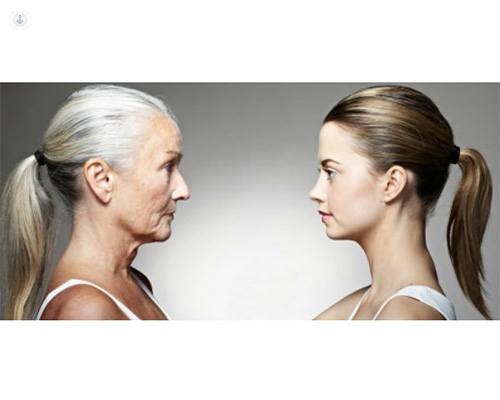Lesiones cutáneas causadas por el fotoenvejecimiento de la piel
Written by:The doctor. Vilata is a recognized specialist in Dermatology of Valencia that in this article explains how to avoid premature aging of the skin. In addition to giving the keys to differentiate those benign and malignant lesions.
One of the most frequent consultations in dermatology clinics are the changes produced in the skin due to the passage of time and the action of the sun. These injuries concern patients both for social, aesthetic and even psychic aspects that entail, and that usually appear after 40 or 50 years.
It is much more important to treat them from a health point of view because of the possibility of finding cancerous lesions, which are of high incidence in sunny countries.
Care to avoid skin lesions
Advances in medicine along with the increase of healthy habits such as good nutrition, moderate exercise and other factors that promote health have meant that in the last 25 or 30 years in Western countries the population and life expectancy have increased in both the woman as in the man.
It is logical that the skin, the most external organ of the human body, has suffered many external aggressions for years due to environmental changes (sun, wind, cold, environmental pollution) and other factors such as inheritance, poor nutrition, labor aspects and smoking, fundamentally.
For this reason, the skin must be taken into account and constantly monitored so that the first signs of aging do not become future precancerous and cancerous lesions in which the fundamental cause is sun that has been indiscriminately taken for many years, in addition to the factors discussed above.
The aging of the skin
The skin, also with the years suffers a process of intrinsic aging (inexorable passage of time) like any organ of the body. All the organs are progressively aging, decreasing their functioning in unison and increasing their capacity to become ill. There is really a general progressive deterioration that manifests itself more in some people than in others. This deterioration causes environmental factors to affect the skin much more and accelerates the process of suffering various injuries, some with a benign and other malignant.
Therefore, two aspects can be observed in the deterioration of the skin: intrinsic aging and "photo-aging" by the action of solar rays throughout life (chronic sun exposure), generally in an indiscriminate manner, including the radiations of artificial ultraviolet rays of cabins. It must include the reflection of the solar rays coming from water, sand, walls or white surfaces and snow.
Not only the action of the rays, but the color of the skin, influence as a very important factor in photoaging. People with very white skin often burn with the sun and it costs them much more to tan. It is red-haired people with white skin who suffer many more skin lesions over the years. And more in areas such as the face, neckline, shoulders, arms, legs, etc., according to areas that are mostly exposed.

Clinical manifestations of photoaging
The clinical manifestations of skin photo-aging that appear on exposed skin are multiple. Among the benign ones are:
- The wrinkles : that can be observed very thin and as grooves in very deep occasions.
- Skin dryness (xerosis): very common and usually seen on the back of the legs and arms. It is important to apply moisturizers frequently.
- Skin atrophy (thinning): appears in areas badly damaged by the sun.
- Small arterioles (telangiectasias): they are observed by transparency of the thinned skin and the capillaries are also dilated. They are very common on the face, neck and side faces of the neck.
- Solar lentigines (spots or hyperpigmented macules): single or multiple soft touch and circular or oval outline.
- Irreversible diffuse hyperpigmentation : it can be called the "perpetual tanning". It is very common and is seen in uncovered areas such as neckline, face, arms and legs. It is recognized because there has been chronic sun damage.
- Hypomelanosis in drops: multiple spots, acromic (without pigment), oval with a small diameter (4 or 7mm) very frequent on the back of legs and forearms. Sometimes they are accompanied by spots with pseudocicatricial appearance and starry morphology.
- The comedones : can also make their appearance at the level of malar regions in adults.
Among the malignant lesions on a photodamaged skin are:
- Actinic keratosis : scratchy lesions to the touch with detachment of scales / scabs with certain periodicity and that will evolve to squamous carcinoma with different signs such as bleeding, ulceration and potentially metastasis.
- Basal cell carcinoma is the malignant tumor with the highest incidence and develops on skin without a previous lesion, with the appearance of a nodular lesion, with a shiny pearly appearance.. Its malignancy is local, so it must be treated so that it does not affect other nearby areas.
Malignant melanoma is the most dangerous malignant tumor and in its evolution can metastasize in ganglia and viscera ending with the life of the person. Although there are different clinical varieties of it, as a rule it is characterized by a very black lesion of nodular aspect or with an aspect that extends superficially or as a low spot, although it may have different color tones close to black.
The areas most affected by this tumor are the back, neck, chest, legs and abdomen, but it is important to periodically monitor the entire skin surface (including palms and soles) and see a specialist in Dermatology once a year.
Tips to avoid skin lesions
In people who have sunbathed or used ultraviolet radiation cabinets with a certain frequency, injuries similar to those described are observed.. These should consult with the dermatologist to know the clinical diagnosis that in many cases will require a biopsy (remove a piece of the lesion) and send it to the laboratory for confirmation. It will proceed later to its treatment.
In case there are no worrisome lesions on your skin, but have a marked involvement of the skin due to sun damage, you should periodically put yourself in the hands of the dermatologist to try to minimize that sun damage and recommend preventive rules so as not to add more damage to your skin.


